DinoFest 2023: Bones to Beasts
Have you ever wondered how paleontologists go from finding a few bones in the field to reconstructing an entire animal? How scientists can tease out details about how dinosaurs grew and moved? At NHMU's seventh-annual DinoFest, we explored these very questions and more with a lineup of world-class paleontologists who helped us explore their process, from digging up dusty bones to reanimating beasts in the flesh!
Can't get enough DinoFest? Explore past years' themes and speakers here.
Ellen-Thérèse Lamm
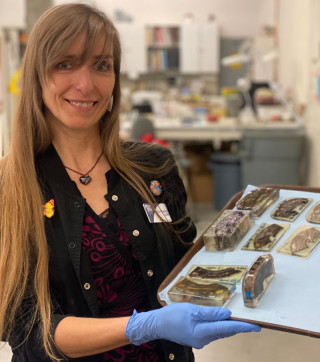
The Paleohistology Puzzle: Microscopic Evidence Solves Dino-Sized Mysteries
Paleohistology allows scientists to answer to big questions about dinosaurs by examining very thin slices of their bones under a microscope. Did you know that the micro-architecture of bones, and of other hard tissues like teeth and eggshells, is impeccably preserved inside a fossil specimen? Discover how fossils are disassembled to put the paleohistology puzzle together using: a variety of dinosaur parts, a multi-step process of extracting samples and restoring specimens, and finally polarized-light microscopy to reveal the remarkable results! Find out how paleohistology helps scientists study dinosaurs as living, growing, active, injured, reproducing animals.
Ellen-Thérèse Lamm is the Histology Lab Manager at Museum of the Rockies in Bozeman, Montana, where she has been the “chief bone-chopper” for over 30 years. Combining her background in biology with her skills in taking dinosaur bones apart (and putting them back together again), her position involves all things paleohistology - using diamond-edged blades and polarized-light microscopes to reveal the exquisite and informative internal structure of fossil specimens. These investigations, delving into dinosaur physiology, health, behavior, and reproduction, have exponentially expanded our understanding of dinosaurs. When not cutting up dinosaur bones, Ellen-Thérèse enjoys carving the ice on figure skates.
Tylor Birthisel
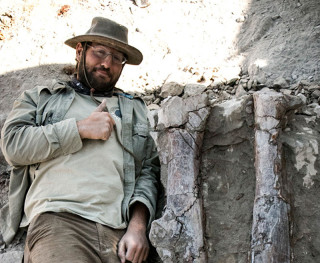
You Found a Dinosaur, What's Next?
Have you ever wondered about the journey a fossil takes before you see it on display in the museum? Follow me as we look at the journeys of several fossils, as we go from their initial discovery, to excavation, to transportation back to the museum, through preparation, and finally on display.
Tylor is the Paleontology Lab Manager at the Natural History Museum of Utah. He specializes in the collection and preparation of fossils from Utah, particularly Cretaceous and Triassic critters. His current area of research centers on the dinosaur Parasaurolophus, looking at how they grew from juveniles to adults.
Dr. Leif Tapanila
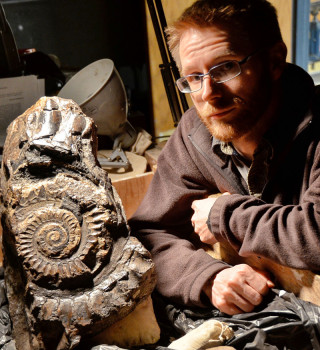
Fishing for the Giant Buzzsaw Shark
The largest predator of its time, the buzzsaw shark swam along the coast of Utah and Idaho nearly 280 million years ago. But its fossil - a tight spiral of more than 125 teeth - mystified paleontologists for over a century. Thanks to advances in CT-imaging we are able to see the jaws of the animal for the first time, and show how this marvelous beast chomped its way to the top of the food chain! Get ready to see the weirdest shark in history.
Dr. Leif Tapanila is a Professor of Geosciences and Director of the Idaho Museum of Natural History at Idaho State University. His research spans a wide range of topics, from investigating the aftermath of meteor impacts to creating a 3D digital zoo of the world’s largest animals. As a paleontologist, he’s interested in how life adapts to an ever-changing world, and he really loves the creative process in solving a challenging question.
Emily Lessner
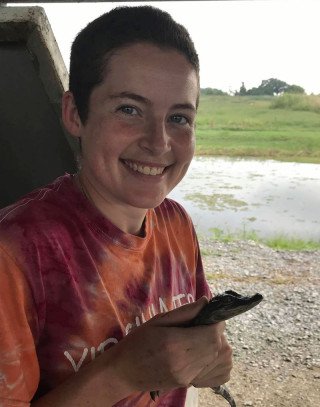
Dinosaur Face Touch: Fossil Evidence for Nerves and Senses in Ancient Animals
How did dinosaurs interact with their environments? Were they relying on their eyes, ears, and noses to get around? What about their skin and sense of touch? Dr. Lessner will discuss how dinosaurs made use of nerves in their faces while living and explain how paleontologists reconstruct soft tissues and behaviors of extinct animals.
Dr. Emily Lessner is a vertebrate paleontologist who studies the sensory systems and behaviors of living animals and uses this knowledge to make hypotheses of soft tissue and behavior in extinct animals. She is interested in how organisms change in response to changing environments and focuses on Mesozoic reptiles. She participates in fieldwork all over the American Southwest.
Brian Engh

Scales, Scutes, Spikes, & Plumes: Exploring the Dizzying Diversity of Dinosaur Skin Through Paleo Art
We fuzzy mammals once thought all dinosaurs were covered in scaly skin or thickened armor reinforced with bone. But, over the course of nearly two centuries, new fossils have proven that many families of dinosaurs also evolved fuzz, quills, feathers, and a bunch of features in between. Brian will explore the astonishing diversity of dino skin-adaptations, their possible functions, and their implications for reconstructing these remarkable extinct animals in art.
Brian Engh is a filmmaker, artist, and naturalist from California. For the past 10 years Brian has made paleoart the focus of his career, frequently collaborating with paleontologists based in Utah to explore, excavate, and depict Utah's fossil-history through art. He is currently working with the Utah Field House Museum to document new discoveries in the Late Jurassic Morrison Formation, while creating art for several new museum exhibits.
Dr. Casey Holliday
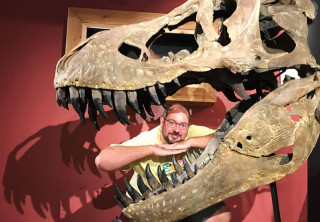
Inside Dinosaurs: Jaw Muscles, Feeding Function, and Skull Evolution
Dinosaurs evolved myriad of adaptations to tackle a variety of diets. Essential to feeding are the jaw muscles which enable chewing and biting and sculpt the skull in a variety of ways. Here we explore how we reconstruct the 3D anatomy and mechanics of jaw muscles and what they mean for the biology and evolution of dinosaurs and their living relatives.
Dr. Casey Holliday is a paleontologist and professor of anatomy at the University of Missouri School of Medicine. He uses comparative anatomy and biomechanics to reconstruct the jaw muscles, joints, nerves and other soft tissues of extinct species to understand how the heads of dinosaurs and their relatives were built, how they worked, and how they evolved. His research has taken him to live gator pits, the red rocks of the Triassic, and inside dinosaurs using imaging and modeling approaches.
Natalie Toth
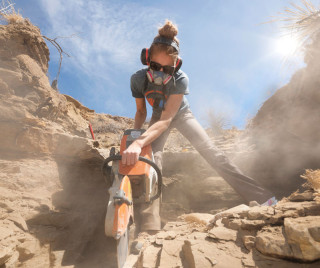
Digging Up Dinosaurs 101
In Utah and Colorado, you really can find a dinosaur bone in your backyard. Teams of trained paleontologists make discoveries every day, but sometimes, new fossils are uncovered completely by accident in unexpected places. Natalie will discuss the process by which paleontologists decide where to dig and why, how fossils are carefully uncovered in the field, and the tricky, but exciting ways in which dinosaurs are transported safely back to the Museum for research, education, and exhibition.
Natalie is the Chief Fossil Preparator at the Denver Museum of Nature & Science. She works with an incredible team of paleontologists, interns, and volunteers to find, collect, and repair Jurassic and Cretaceous vertebrate fossils from the American West and Madagascar.
Carrie Levitt-Bussian
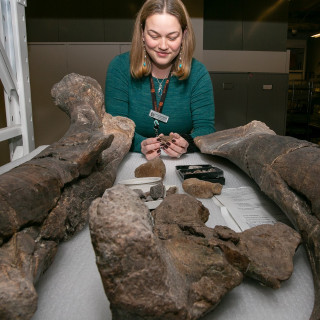
Fantastic Beasts and (I Know) Where to Find Them
Ever wonder what it is like to be a librarian, but for fossils? As Paleontology Collections Manager, I get to work with all different types of fossils from gigantic dinosaurs, to microscopic lizard teeth, to fossilized flowers, to ammonites the size of car tires, and beetles trapped in tar! Join me as I show off highlights from our paleontology collections.
Carrie Levitt-Bussian is a paleontologist and the Paleontology Collections Manager at the Natural History Museum of Utah. She manages over 50,000 paleontological specimens at NHMU which includes vertebrate, invertebrate and paleobotanical fossils. Her expertise is in ceratopsian limb bone histology studying how animals, such as Triceratops, grew and what their metabolism was like when they were alive.
Tim Lee

I Ran Into a Dinosaur and Lived to Talk About It
Most people will run into a dinosaur at some point in their lives. A few of us turn a chance encounter into a passion and then a career. But all of us can participate in the adventure of paleontology and participate in exciting new discoveries. As an exhibit designer, I’ve worked with diverse teams to develop dinosaur exhibitions over the years. See what it takes to make a dinosaur exhibition. Next time you run into a dinosaur, what adventure will you choose?
Tim Lee has worked at the Natural History Museum of Utah for over 20 years. As Director of Exhibits he manages the Special Exhibits program and works with his team to develop, design, and fabricate original in-house exhibitions like, Weaving a Revolution, Nature All Around Us, and the upcoming, Climate of Hope. He says that exhibition design, at its essence, is storytelling through space and time. He works with diverse, multi-disciplinary teams to communicate science in memorable and surprising ways.
ReBecca Hunt-Foster
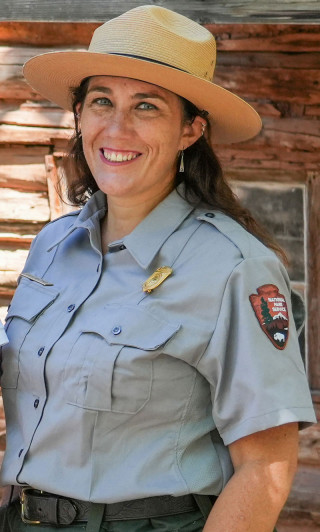
Dinosaur National Monument: A Cornerstone of Late Jurassic Dinosaur Paleobiology
Discovered in 1909, the famed Carnegie Quarry helped to blaze a path to better understand the Jurassic world. While not all the fossils discovered within the quarry were new to science, the specimens it has yielded have provided information that help us to better understand how these animals lived, and died, 150 million years ago. Included now as part of Dinosaur National Monument, the quarry still reveals new insights about these dinosaurs and our past world.
ReBecca is the Paleontologist at Dinosaur National Monument. Her research focuses on Early Cretaceous ornithomimosaurs from North America, the Upper Cretaceous Williams Fork Formation paleofauna of western Colorado and eastern Utah, the ichnofauna of the Lower Jurassic to Early Cretaceous rocks of Utah. ReBecca has worked as a paleontologist in western Colorado and eastern Utah since 2007.
Want More DinoFest?
If you've made it this far and are still craving more paleontology, then learn more about DinoFest here.
Or, check out our blog where you can find articles on paleontology and much more.